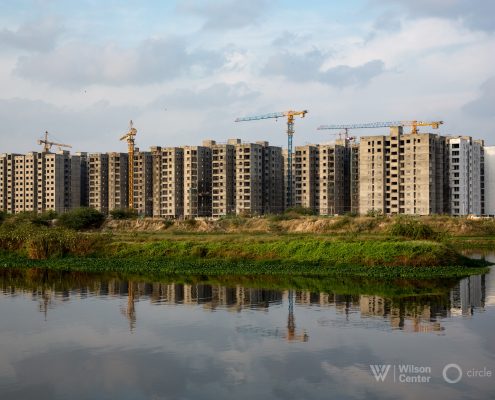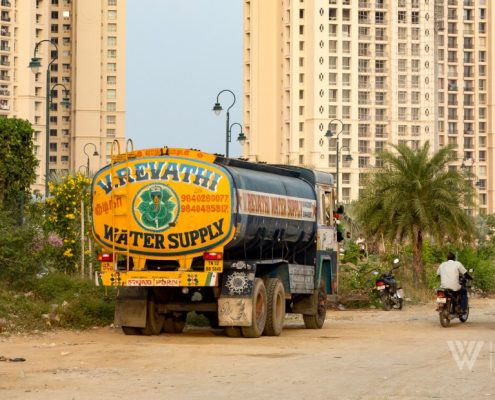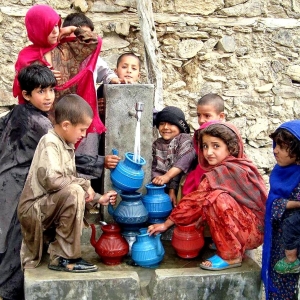The megacity in southern India, as it waits for the monsoon, is not the first to run short of water. It won’t be the last.
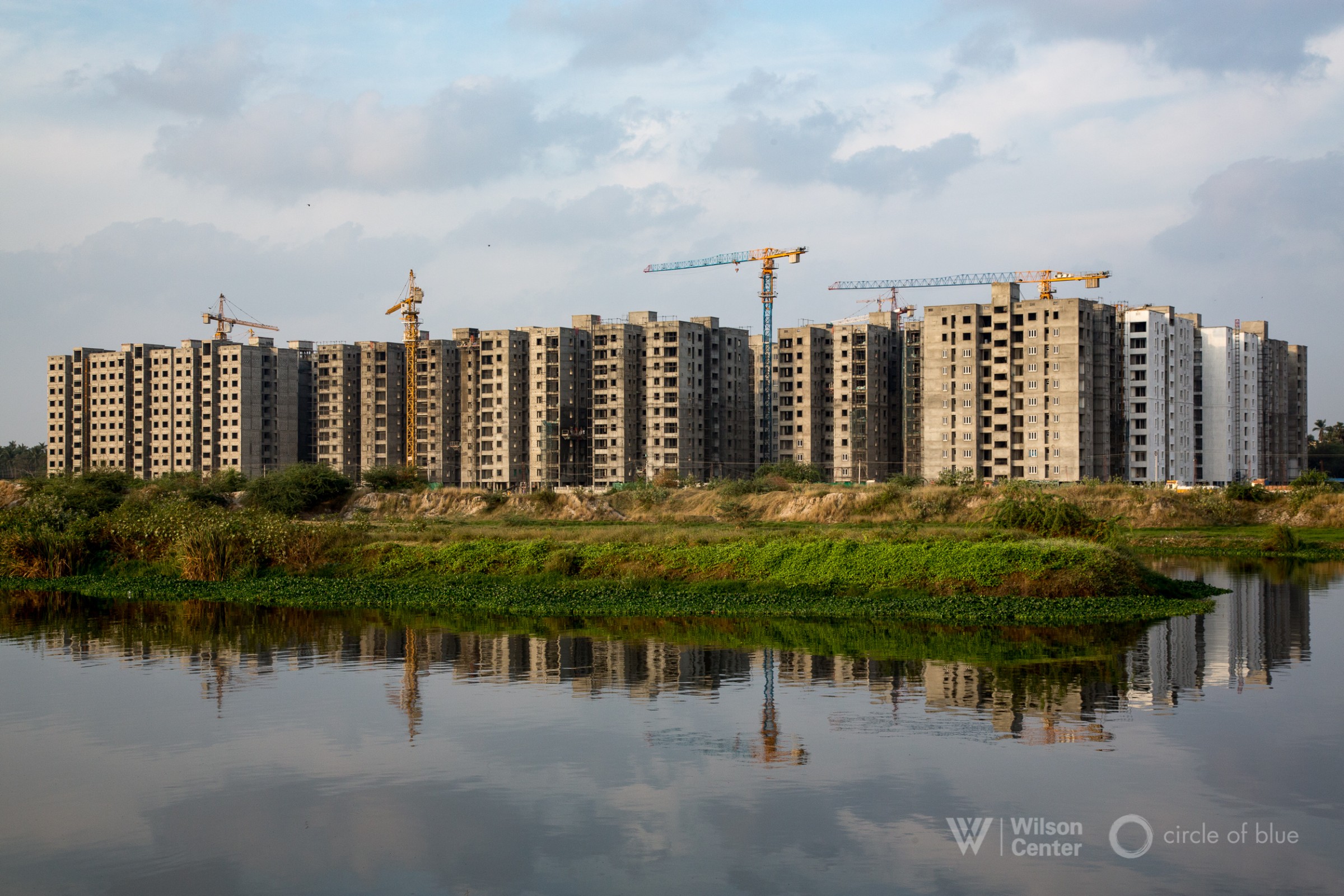
The Pallikaranai Marsh, the city’s largest wetland, is being filled in with residential towers and other construction projects. Land use activists are pushing Chennai officials to preserve the city’s flood-absorbing, water-storing wetlands. Photograph © Circle of Blue/Dhruv Malhotra
By Brett Walton, Circle of Blue
June 23, 2019
Residents of Chennai, by all accounts, are miserable and anxious. The city’s main reservoirs are dry, depleted by the failure of successive monsoons to provide replenishing rains. The shortfall has crippled the piped distribution network, which is now meeting just half of typical demand through a mix of secondary sources: desalinated water, groundwater, and the impoundments from nearby stone quarries. Even that supply is far from adequate. Piped water reaches households once a week or less. Tanker trucks, an expensive alternative, dole out water by the bucketful to desperate crowds.
The emergency is partly a failure of weather. The October-December monsoon, a dud last year, accounts for roughly 60 percent of Chennai’s water supply, says Nisha Priya of The Nature Conservancy India. For three years monsoon rains have been inadequate. But the misery also a failure of city authorities to recognize and plan for water-supply vulnerabilities, argues Samrat Basak, director of urban water for World Resources Institute’s India office.
Chennai water crisis is not an overnight situation.” Samrat Basak, World Resources Institute India
Ninety percent of the city’s wetlands, which store and purify water, have been filled in or damaged during a five-decade period of encroaching urbanization. Little care is taken of groundwater, which is declining. More recently, the water board has been slow to encourage wastewater reuse or even to treat much of the city’s sewage.
“Chennai water crisis is not an overnight situation,” Basak wrote to Circle of Blue in an email.
Chennai finds itself part of a growing club of cities where severe droughts have caught authorities off-guard as they watched reservoirs drain. In 2018, Cape Town veered dangerously close to running out of water. Four years earlier, the water utility that serves 20 million residents around São Paulo extended intake pipes deeper into shrinking reservoirs. Years before that, Barcelona and the government of Cyprus accepted emergency water deliveries via cargo ship when their reservoirs bottomed out.
That Chennai is facing water supply pressures is not unexpected. It was listed in a 2018 study by the University of Kassel and The Nature Conservancy as one of the world’s 20 cities that will have the largest deficit of surface water by the 2050s. In the analysis, deficits were driven by population growth and climate change.
What about shorter time frames? Rather than peering decades into the future, can researchers pinpoint cities at risk several months or years in advance? The Nature Conservancy’s Rob McDonald, a contributing author on the water deficit study, told Circle of Blue that he does not know of any global forecasting tool with that scope and power. The data — combining reservoir levels, seasonal weather forecasts, water supply calculations, evaporation, water demand, groundwater levels, conservation laws, and more — isn’t available in many places, he said.
Technical tools for gathering hydrological data are improving, said Betsy Otto, global director of water for the World Resources Institute. Researchers are using satellites to track harmful algal blooms and airplane-mounted lasers to gauge the snowpack in California’s Sierra Nevada mountains. Satellite measurements trigger drought-related insurance payments to Kenyan herders and inform a drought-monitoring system in the Horn of Africa, the Sahel, and Central America that signals in advance the risk of famine.
But technical tools alone are insufficient, McDonald said. Just as important is what he calls “the human dimension.” By this he means the laws for defining who has priority to water, and the ability to restrict water use and track demand.
Otto agreed that weather forecasting is only part of the risk equation. Understanding institutional deficiencies is essential, too.
“In many cases, cities don’t have the managerial capacity or don’t ring alarm bells early enough,” Otto told Circle of Blue. Water supply may be less than assumed if groundwater withdrawals are not monitored and tanker trucks and farmers are allowed to pump without oversight, she said.
Local officials are starting to learn the lessons. The Chennai government plans to restore 210 wetlands in the city, and has nearly completed about 100 of them, according to Priya, who is helping implement the project. Wetlands restoration has wet-season benefits, too. Besides storing water during drought, marshy areas help to reduce flooding. Chennai was overwhelmed in November and December 2015 with 67 inches of rain. Such are the swings of the monsoon.
Though a source of future dividends, the wetlands projects provide little relief today. In the meantime, the misery continues for Chennai residents.
“Since the city’s water supply has reduced from once in three days to once in 10 to 15 days, the people are water starved and are paying exorbitant costs to water suppliers who bring water from neighboring districts,” Priya wrote to Circle of Blue in an email. “It is very difficult for people who can’t afford such high prices or are waiting for tanker lorries for two to three hours to get only rationed two pots [approximately 10 gallons] of water per family on a day.”
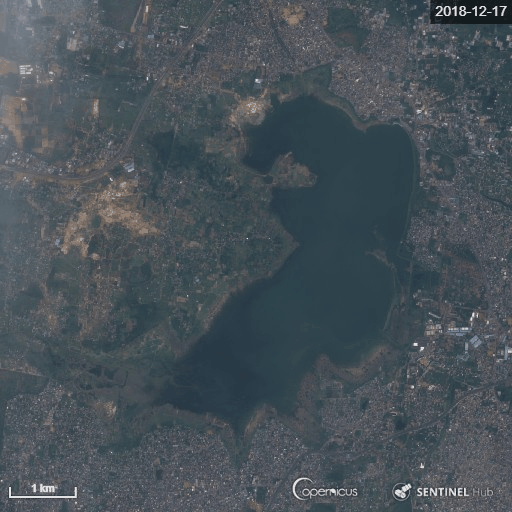
Satellite images from December 2018 to June 2019 show the drying up of Puzhal Lake, also known as Red Hills Lake, which is one of the four main reservoirs for Chennai.
More Chennai
Brett writes about agriculture, energy, infrastructure, and the politics and economics of water in the United States. He also writes the Federal Water Tap, Circle of Blue’s weekly digest of U.S. government water news. He is the winner of two Society of Environmental Journalists reporting awards, one of the top honors in American environmental journalism: first place for explanatory reporting for a series on septic system pollution in the United States(2016) and third place for beat reporting in a small market (2014). He received the Sierra Club’s Distinguished Service Award in 2018. Brett lives in Seattle, where he hikes the mountains and bakes pies. Contact Brett Walton

